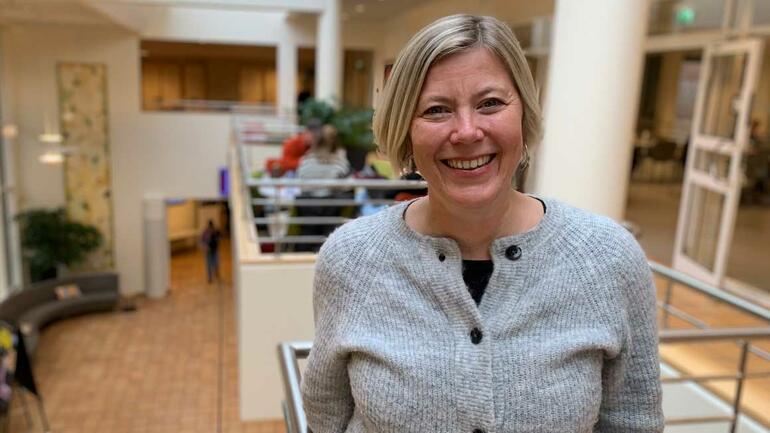The proportion of female professors at USN has increased from 28.7% in 2019 to 37.3% in 2022. In 2022, the university was employing 67 female professors, compared with 39 in 2019. The number of readers has also increased to 12 FTEs (full-time equivalents) in 2022, compared with just seven 2019.
The proportion of female professors and readers at USN is 38.8%, compared with the Norwegian university average of 36.13%. Moreover, the proportion of female associate professors and senior lecturers has also increased, as is shown in the table below.
Greater influence in subject fields
Heidi Stavrum was promoted to the position of Professor of Cultural Studies in 2022. At 45, she is a very young professor with a prolific career behind her.
Stavrum majored in cultural studies at the former Hedmark University College before completing her doctorate in Norwegian dance band music and culture. She worked for ten years at the Telemark Research Institute and was appointed associate professor at USN in 2018.
She has lectured bachelor students in cultural management studies, and both master’s and doctoral candidates in cultural studies. En route she has also published several books and a number of scientific articles. On the basis of her accomplishments, the assessment committee judged that she was qualified to be awarded a professorship in June 2022.
“I am both pleased and very proud to have been awarded a professorship. It was all a bit overwhelming at first, but I’m still the same person I always was”, she says.
As a professor, Stavrum is experiencing having greater influence, both in her subject field and at USN as a whole – not least when it comes to the research projects she can apply for and participate in.
“As a professor, I have a greater influence over the projects I take part in”, she says. “But I also very much enjoy working with other researchers and writing articles together with colleagues in my field. Although academia can at times cultivate a somewhat individualistic culture, I am still very committed to the collective. I would never have become a professor without the help of excellent co-authors in my various academic communities.”
Global female solidarity
In 2017, USN launched two internal qualification programmes to encourage promotion to the positions of reader/professor and senior lecturer, respectively. A thorough assessment has since been carried out of the qualification programme for the post of senior lecturer. Findings indicate that the programme has been key to boosting the number of promotions.
The 2022 Annual Report stated that during the last five to six years, USN has seen a positive trend in the number of employees with senior competency and will continue to work systematically to increase the number of FTEs in these positions in the years ahead.
“It helps to focus on areas that need improvement”, says Tony Burner, who chairs USN’s equal opportunities and inclusivity committee. “This is a field in which USN has seen excellent development in recent years and I’m very pleased with these great results. That we sometimes even deliver above the national average in terms of the proportion of female professors is very good news”, he says.
Stavrum is committed to equal opportunity and has always felt that she is working in an equality-based setting on the USN campus at Bø in Telemark. She wrote her graduate thesis on equal opportunity in the field of music and jazz and has participated many times in celebrating International Women’s Day on 8 March.
On the home front she occupies herself in the main with improving conditions in the female-dominated occupations, believing strongly that it is essential to improve salaries and working conditions for both teachers and health care workers. But the biggest structural changes, she argues, have to be made across the world as a whole.
“I see the demonstration of solidarity with women across the world as very important”, says Stavrum. “The status of women in countries such as Iran, Ukraine and Afghanistan is a burning cause that is well worth fighting for”, she says.
Table: Overview of academic positions held at USN in the period 2019 to 2022 (as of 1 October), showing both total FTEs and the proportion of women.
|
|
2019 |
|
2020 |
|
2021 |
|
2022 |
|
|
Position |
FTE |
Percentage |
FTE |
Percentage |
FTE |
Percentage |
FTE |
Percentage |
|
|
total |
women |
total |
women |
total |
women |
total |
women |
|
Professor |
135,8 |
28,7 |
151,1 |
31,3 |
172,7 |
35,2 |
178,9 |
37,3 |
|
Reader |
18,9 |
7,9 |
22,0 |
40,9 |
23,0 |
43,5 |
25,0 |
48,0 |
|
Associate professor |
301,7 |
54,0 |
303,9 |
55,0 |
303,8 |
52,7 |
341,0 |
53,8 |
|
Senior lecturer |
112,0 |
55,6 |
112,9 |
55,3 |
125,2 |
57,7 |
127,2 |
61,1 |
|
Univ. Coll. reader |
2,0 |
- |
- |
- |
1,0 |
- |
1,0 |
- |
|
University lecturer |
342,8 |
60,6 |
329,0 |
59,7 |
322,4 |
62,3 |
331,0 |
63,8 |
|
Research fellow (internal) |
30,8 |
61,8 |
36,0 |
70,1 |
37,8 |
65,6 |
33,5 |
61,2 |
|
Research fellow |
122,8 |
52,3 |
120,45 |
57,9 |
140,5 |
63,4 |
147,3 |
60,3 |
